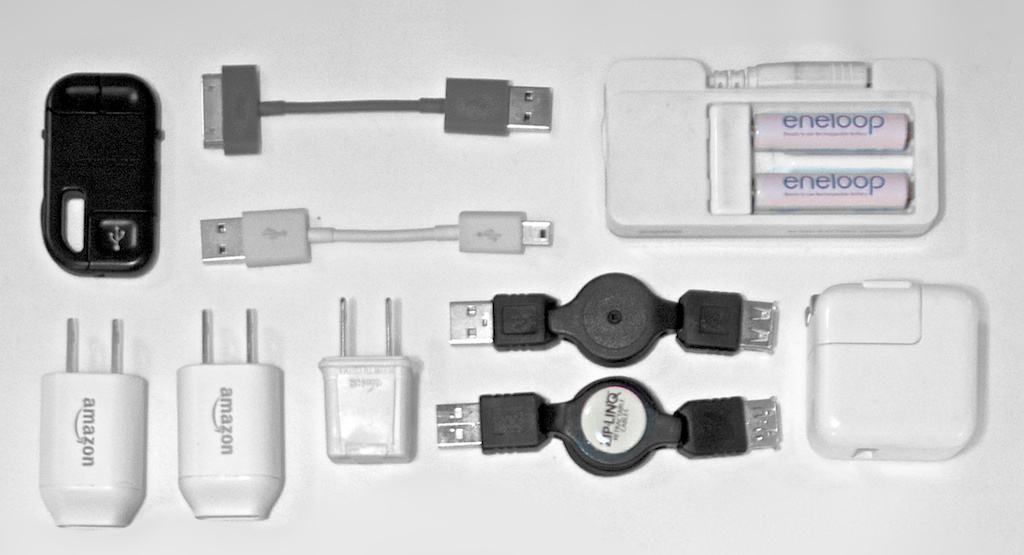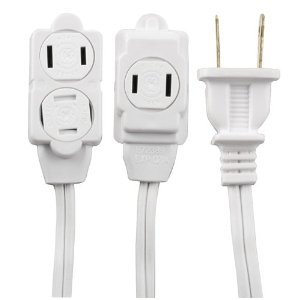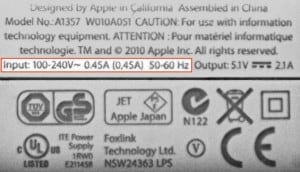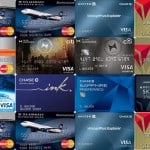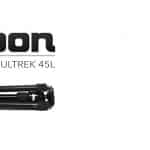Have you ever been packing for a trip and found yourself thinking that if your could cut out half the weight and space of your charging cables, you would be able to just pack a carry on?
As we prepared for our 12+ month around-the-world-trip, we didn’t quite manage to fit everything into a carry on, but we were able to find a lot of helpful ways to reduce the size and weight of our chargers. As I’m sure we are not the only ones who are frustrated by the space and weight of these things while traveling, we thought we’d share our solutions and some other options that have since been discovered as well.
The first item we wanted to reduce was the power adapters for our two computers.
You have been lugging two computers around the world on your backs!?!
Yes. We would not recommend it for everyone and for most couples, one computer or a tablet would probably work fine, but, as Griffin is running a Design Company and Valerie’s computer weighs less than many tablets, that is conclusion we came to. That being said, we would not recommend it for most people and Griffin does not enjoy lugging around his 5+ pound behemoth of a laptop all that much.
Power Cables
We researched and tried to find a smaller, lighter option from the 45 and 85 Watt power bricks we had and found some interesting options, but nothing that seemed to be worth the time or additional money for our needs. We also knew we didn’t want to get rid of the 6 foot extension cables from our chargers as many times, they are needed to reach from outlets to our laptops. In the end we ended up going with a 6 foot extension cable to share between our two adapters and this has worked really well. We made sure to get one with three plug on the end so that we could charge two commuters, or one computer and two other devices if needed.
USB Chargers
Once we had reduced our laptop cables by one extender, it was time to move on to our USB Devices. We travel with the following USB rechargeable items:
- iPhone(2) – These have changed travel for us forever! Griffin traveled for 6 months in 2007 before the iPhone came out and had to spend hours researching online for hostels, train routes, maps, tourist information, hotel directions and more. Now with the iPhone and all the amazing travel apps that have been made for it, within about 20 minutes, we can find and book a hostel, get train directions to that city from our current city, get walking directions from the train station to the new hostel and look up things to see and do in the new city all without needing to waste paper with printing or writing all the information down.
- iOS Backup Batteries(2) – We use these on long trips to get some extra use out of our iPhones, iPods or iPad as desired.
- iPod Classic(2) – Capable of holding the most music and also has a much longer battery life than our iPhones. In addition, we use these as back up hard drives for our important documents and files as they really are just music playing multifunction hard drives.
- Kindle(1) – Valerie reads all her Jodi Picult novels on this and we also use it for internet when we have no other options as it has free 3G in most countries around the world.
- iPad(1) – Griffin uses this for all his reading as well as for quality checks when designing and testing interactive iBooks and Custom eBook Templates for his clients.
- AAA(4) & AA(2) Batteries – (These may not seem like USB rechargeable items, but we’ll get to this in a minute.) We use the triple A batteries to charge one of our favorite travel accessories – our in-ear noise canceling Audio Technica Earphones. We keep one in each set and two charged up in the charger. The Double A is used for Griffin’s Whahl trimmer which we use to save money on hair cuts and to try and keep his beard under control.
OK, so we know this is a long list and that all of these items are wants, not needs especially for travel, but we enjoy them enough to lug them around and some of them are needed for business and sanity reasons as well. (We always seem to get the seat right next to the only crying baby on the plane, train, bus or boat no matter what!) That being said, we have them and we needed to figure out a way to charge them with as little equipment as possible.
Let’s first look at the iOS devices since we have seen that most travelers have them and the charging systems for them, while small, can be made even smaller with a little effort and research. Here is what we use to charge these:
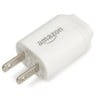 Kindle USB Power Adaptor(2) – These are thinner than the standard apple USB chargers and allow us to fit two of them on the 6 foot extension cable listed above whereas we could only fit one of the Apple iPhone chargers, so we left those at home.
Kindle USB Power Adaptor(2) – These are thinner than the standard apple USB chargers and allow us to fit two of them on the 6 foot extension cable listed above whereas we could only fit one of the Apple iPhone chargers, so we left those at home.
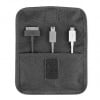 InCase USB Mini Cable Kit(2) – These are awesome. They come with an iPhone/iPod/iPad charge/sync cable as well as a mini and micro USB cable and they are all only about 3 inches long, so they take up no space or weight. We recommend this kit over other options as it is to Apple specs and works with any and all iOS cases even ones as exacting as the LifeProof Case whereas the others we have tried do not.
InCase USB Mini Cable Kit(2) – These are awesome. They come with an iPhone/iPod/iPad charge/sync cable as well as a mini and micro USB cable and they are all only about 3 inches long, so they take up no space or weight. We recommend this kit over other options as it is to Apple specs and works with any and all iOS cases even ones as exacting as the LifeProof Case whereas the others we have tried do not.
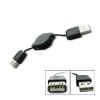 Retractable USB Extension Cable(2) – We use these in case we need or want a little extra length to our cables when charging. The only downside we have found is that, possibly due to how thin they are, they sometimes are unable to sync and they also tend to fray somewhat easily. We have replaced one of them while on this trip, but had already gotten about two years of use out of it by then, so not a big issue. If we need to sync then we just unplug and use the short cables and are good to go.
Retractable USB Extension Cable(2) – We use these in case we need or want a little extra length to our cables when charging. The only downside we have found is that, possibly due to how thin they are, they sometimes are unable to sync and they also tend to fray somewhat easily. We have replaced one of them while on this trip, but had already gotten about two years of use out of it by then, so not a big issue. If we need to sync then we just unplug and use the short cables and are good to go.
Now you may have noticed that the above options will also work to charge any electronics that use Micro and Mini USB such as some camera, cell phones, Kindle and more.
In order to charge our batteries, we purchased the following:
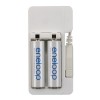 AA & AAA USB Battery Charger – We use this with a set of two AA and four AAA eneloop rechargeable batteries and it works great. It is small, compact and we like that is can easily charge both types of batteries. As a side note, we highly recommend eneloop batteries linked above. They are a little more expensive, but, currently, they are by far the best as far as number of charge cycles, quick recharge, and charge length.
AA & AAA USB Battery Charger – We use this with a set of two AA and four AAA eneloop rechargeable batteries and it works great. It is small, compact and we like that is can easily charge both types of batteries. As a side note, we highly recommend eneloop batteries linked above. They are a little more expensive, but, currently, they are by far the best as far as number of charge cycles, quick recharge, and charge length.
NOTE: We also have brought along the included Apple iPad Charging brick as it is needed to quickly and fully charge the iPad. That being said, we have seen USB adapters that claim to boost the normal USB output in order to be able to charge the iPad, but are a little skeptical as the ones we have seen all seem to be made by no-name companies in China and probably aren’t too reliable.
Alternative Options:
While we have used and are quite happy with the above system, since we have left the U.S., we have seen some new and clever alternatives become available. They are listed below.
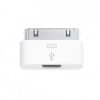 Apple Micro USB to iPhone Adapter – If you wanted to cut the above set up down to one less cable, you could purchase this adapter made by Apple for the European market and get rid of the purpose built iPhone adapter above. Alternatively, you could keep the three cables and have the option to charge 1 iPhone/iPod, 1 Micro USB device, and 1 Mini USB device or 2 iPhone/iPods and one Mini USB Device with the adapter.
Apple Micro USB to iPhone Adapter – If you wanted to cut the above set up down to one less cable, you could purchase this adapter made by Apple for the European market and get rid of the purpose built iPhone adapter above. Alternatively, you could keep the three cables and have the option to charge 1 iPhone/iPod, 1 Micro USB device, and 1 Mini USB device or 2 iPhone/iPods and one Mini USB Device with the adapter.
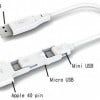 Innergic Magic 3 in 1 Charge Cable – We have not tried this out ourselves, but it looks like it could be a pretty cool solution with two caveats. First, you could only charge one device at a time, which is usually not ideal and secondly, if any of the end pieces break or malfunction, you are stuck with a useless cable depending on which one it is. For these reasons, we would not recommend this as your only charging solution except for maybe on short trips where new cables could be purchased easily if needed.
Innergic Magic 3 in 1 Charge Cable – We have not tried this out ourselves, but it looks like it could be a pretty cool solution with two caveats. First, you could only charge one device at a time, which is usually not ideal and secondly, if any of the end pieces break or malfunction, you are stuck with a useless cable depending on which one it is. For these reasons, we would not recommend this as your only charging solution except for maybe on short trips where new cables could be purchased easily if needed.
Keychain Charge & Sync Cables – These things are really compact and fold away into a self protecting plastic shell. They come in different versions including one for Micro and Mini USB and one for iPhone/iPods, etc. We have purchased and used the Micro and Mini USB one and can highly recommend it as an option.
Storage
While you could just store all these things in a plastic bag or something, as for the USB cables and power adapters, we have been using the smallest envelope from this Travelon set and find it works perfectly. Initially, I was not impressed with these as the zipper seems to weigh about five pounds and seems excessive for a travel specific bag, but as we have used them over the last 11+ months they have proven to be amazingly durable and tough.
The rest of the items we throw in a zip-able mesh type bag so we can easily see what is in there, but also easily pack it by moving things around inside, if needed, to fit into a tight space. Another cool option we have considered, but not tried, would be to use one of these cool Grid-it systems to keep it all together and organized.
Extra Outlets
If you find yourself needing more outlets, as we did, here is the best solution we have found so far:
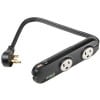 Monster Cable Outlets To Go 3 Plug Outlet wit USB – This is the smallest, lightest, and most versatile three outlet option we could find. This three port charger wraps nicely around itself for easy and compact storage and has one USB charging port as well. We don’t use this all the time, but when we need it, it is awesome and only takes up a small amount of space in our bag.
Monster Cable Outlets To Go 3 Plug Outlet wit USB – This is the smallest, lightest, and most versatile three outlet option we could find. This three port charger wraps nicely around itself for easy and compact storage and has one USB charging port as well. We don’t use this all the time, but when we need it, it is awesome and only takes up a small amount of space in our bag.
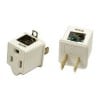 3 Prong to Two Prong Adapter – If you are going to take along the above power outlet, you may find times you will need to use it without the third ground pin (the round one), so you can either remove the ground pin (not recommended, but an option), or buy one of these for about a dollar and have both options available.
3 Prong to Two Prong Adapter – If you are going to take along the above power outlet, you may find times you will need to use it without the third ground pin (the round one), so you can either remove the ground pin (not recommended, but an option), or buy one of these for about a dollar and have both options available.
Plugging It All In
There seems to be a lot of confusion among frequent travelers and non-frequent travelers alike as to what is needed when heading off to another country in terms of being able to plug in your electronics and making sure they don’t blow up or catch on fire because of the higher voltage, etc. Many think you need a heavy and expensive voltage converter as well as plug adapters, and, for some things that would be the case, but for 90% or more of electronic equipment, you will not be needing a heavy and expensive voltage converter. Let me say that again.
For 90% or more of electronic equipment, you will not need a heavy and expensive voltage converter.
Not only do you most likely not need one, but there is an easy way to check each piece of equipment you have in order to make sure. What you need to do is look for small writing usually found of the charger for your equipment or sometimes on the actual electronic. It is usually next to some logos and company names like the UL Listed, CE, and maybe a “do not throw away” logo, etc as seen below on the Apple iPad Charging brick.
What you are looking for are words similar to or including:
Input: 100-240v~ 50-60Hz
This means that the device can handle a range on input voltage from 100 all the way up to 240 and means you can safely use it in every country in the world without a voltage converter. If your device reads something like Input: 100-120v~… then you cannot use it in any country with more 120v of power without a voltage converter. Hope that helps.
Once you have determined whether or not you need a voltage adapter, the next thing you will need is a plug adapter to allow your plug to fit in a plug socket from another country. If you are only going to be visiting one continent or country, then I would just recommend checking what those places use for plugs and buy the one you need as it will be the smallest and lightest option. You could also just show up in that country and most likely buy an adapter from a local market or hardware store for a lot cheaper, but if you are not willing to risk it, go ahead and pre-order. If you will be visiting a lot of countries with various socket shapes and sizes, then we can recommend universal adapters like the one below:
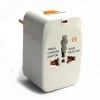 Universal Plug Adapter with Surge Protection – This is about as small and light as these things come and it has worked well for us all around the world. We highly recommend you to make sure the one you buy has surge protection built in, as we were using the power plug on a train in India and it fried our adapter and, more importantly, our Apple Mag-Safe power cable and at about $90 a piece that was not a cheap mistake. It would have been much better to have fried a 10¢ fuze. Lesson learned. Don’t make the same mistake we did!
Universal Plug Adapter with Surge Protection – This is about as small and light as these things come and it has worked well for us all around the world. We highly recommend you to make sure the one you buy has surge protection built in, as we were using the power plug on a train in India and it fried our adapter and, more importantly, our Apple Mag-Safe power cable and at about $90 a piece that was not a cheap mistake. It would have been much better to have fried a 10¢ fuze. Lesson learned. Don’t make the same mistake we did!
In all, we were able to save several pounds of weight and a lot of space simply by changing a few things out for smaller versions. Obviously, some products are better quality than others, but we have personally tried out the things above and can recommend them to anyone looking for better electronics solutions. We hope this stuff helps you as much as it has us!

